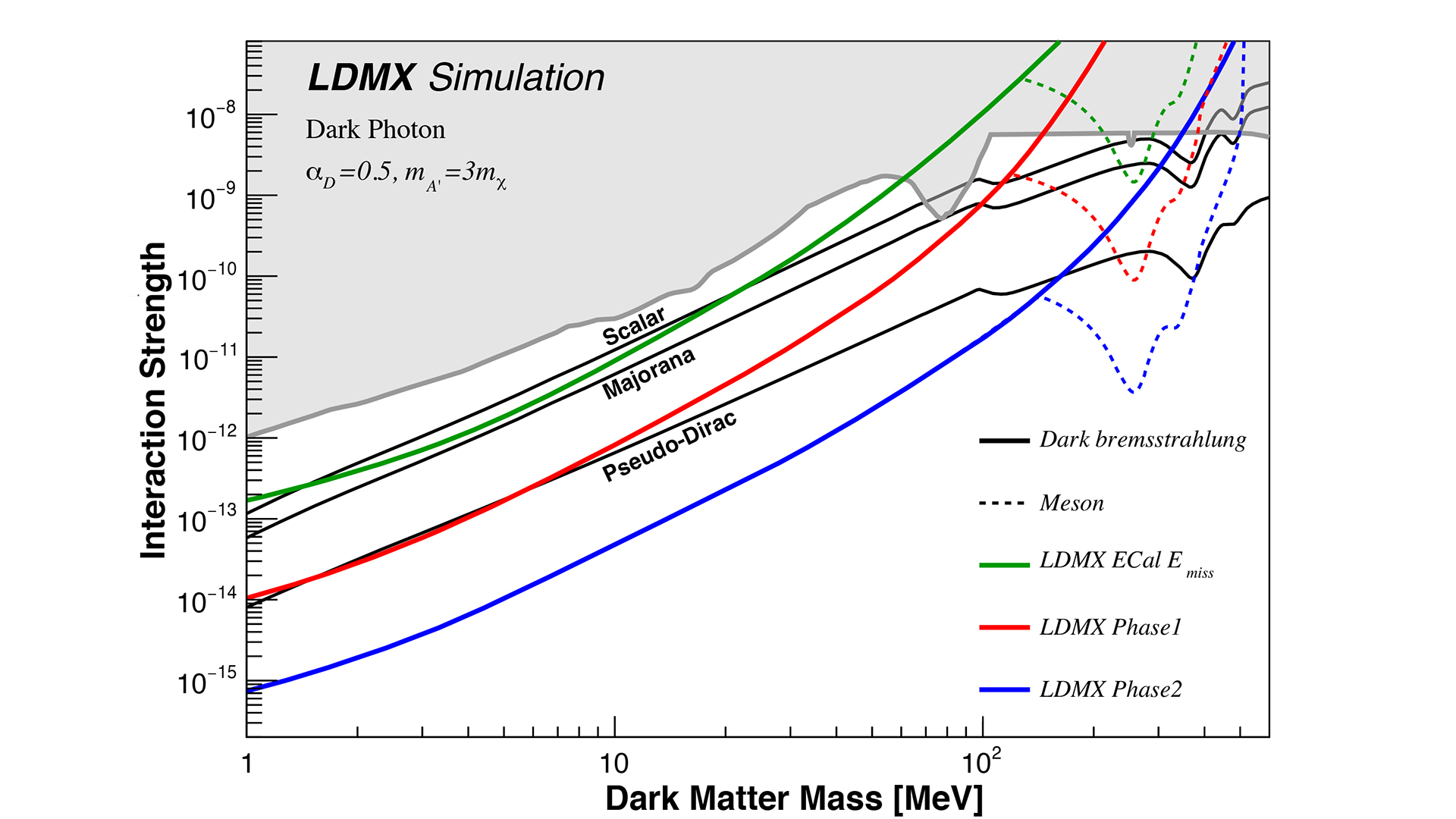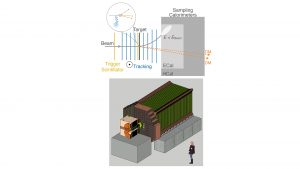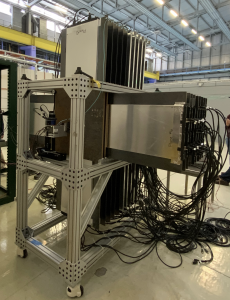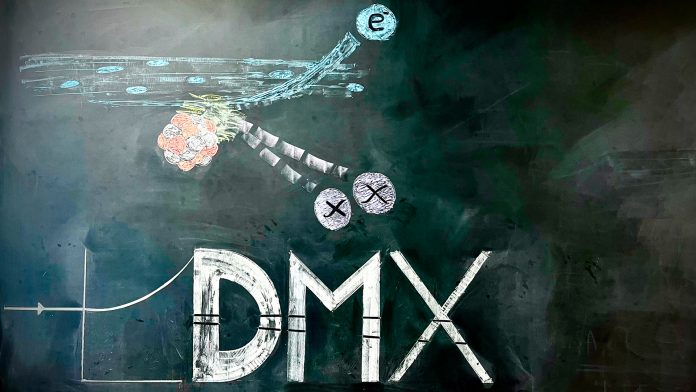Within the next ten years, LDMX – the Light Dark Matter eXperiment – will open new possibilities to explore the dark side of our Universe.
The first hints of the existence of dark matter in the Universe date back almost a century. Today, we know that this non-luminous type of matter accounts for more than 80% of the Universe’s matter content and plays a crucial role in how the Universe evolved to its present state.
Despite all we have learned about dark matter on these large scales, our knowledge of the most minor scales still needs to be completed. Importantly, we still need to understand what the fundamental building blocks of dark matter are. We call these building blocks particles, and we only know that they cannot be the same kind of particles that make up the ordinary matter we experience around us, like the chair you are probably sitting on right now or the stars in the night sky.
Why ‘light’ dark matter?
Many hypotheses exist as to what the nature of dark matter particles might be. In many scenarios, the mass of these particles and their interaction with ordinary matter are not two independent properties. Instead, they are related through the requirement to explain the observed abundance of dark matter.
One compelling scenario, due to its simplicity and predictiveness, is that dark matter is leftover from thermal equilibrium in the early Universe, and the present-day abundance of dark matter was ‘frozen out’ when the Universe expanded and cooled. Within this well-motivated framework of thermal relic dark matter, the range of dark-matter particle-masses is constrained to the region roughly between the mass of an electron (0.5 MeV) and some 10 TeV.
The mass region above a proton mass (1 GeV) has been explored extensively in the search for such dark matter particles, also referred to as weakly interacting massive particles (WIMPs). Still, no unambiguous observation has been made to date. The possibility of particles with masses between 1 MeV and 1 GeV has been investigated much less. Exploring such sub-GeV dark matter has been highlighted as a priority in several community reports over recent years, both in the US1 and Europe2. Several complementary experimental approaches have emerged to close this gap, and accelerator-based experiments are crucial for this effort. One of the most powerful will be realised as the Light Dark Matter eXperiment (LDMX).
Experimental setup and physics reach
LDMX will be a fixed-target experiment: dark matter will be produced in interactions of a particle beam in a target, leading to an imbalance in the momentum between the incoming and outgoing beam particles.
This would be the tell-tale sign allowing us to infer the production of dark matter particles that themselves will not be detectable in the experiment. LDMX is the only currently planned experiment to employ this fixed-target missing-momentum approach. This unique technique provides outstanding sensitivity to discover or exclude the existence of dark matter particles in the mass region between 1 MeV and 1 GeV. This is illustrated in Fig. 1, which shows the interaction strength between dark and ordinary matter as a function of the dark matter particle mass. The black lines correspond to those combinations of interaction strength and mass that result in the correct dark matter abundance for different types of thermal relics. These lines determine how sensitive the experiment has to be, i.e. how small an interaction strength it has to be able to measure. The parameter space already excluded by previous measurements is shown in grey. The coloured lines correspond to different running scenarios of LDMX and show that already with a short initial run (green), new parameter space can be explored. The complete envisaged data set (blue) will provide coverage well beyond the lowest thermal relic lines over a wide mass range – something that will not be achievable to the same extent with any other existing or planned experiment.

LDMX will measure the energy and momentum change of electrons passing through a thin tungsten target. In the target, the electron might interact with one of the nuclei, which in rare cases, can produce dark matter particles via a new, unknown ‘dark’ force. The dark particles will not be detectable but will carry away a significant fraction of the electron’s initial energy and momentum. Dark matter production, the signal, will manifest as an electron that has lost a considerable amount of energy and obtained a sizeable transverse momentum component, i.e. perpendicular to the incoming electron direction. All other known interactions of the electron, referred to as backgrounds, produce detectable particles. It is, therefore, crucial to maximising the efficiency with which the particles from background reactions are observed in the detector.
The main detector components are shown conceptually at the top of Fig. 2. The number of incoming electrons will be counted by segmented scintillators referred to as trigger scintillators. The electrons pass through a tracking detector in a magnetic field both before and after the target. This will yield the measurement of the transverse momentum difference. The energy loss is subsequently determined in an electromagnetic calorimeter (ECal), where the electron will be captured. The ECal is surrounded on all but the front side by the large hadronic calorimeter (HCal) that will serve mainly as a background veto instrument by detecting any particles produced in background reactions that do not interact in the ECal, like neutrons, for example. The lower part of Fig. 2 shows a digital 3D model of the detector with a person for scale, illustrating the modest size for a particle physics experiment. The tracking and target are embedded in the orange-coloured magnet; the ECal is the yellow device behind it, surrounded on the sides and in the back by the large HCal.

Bottom: Rendering of the experiment with a person for scale.
All the main detector components will leverage proven solutions inspired by what has successfully been developed for other experiments, lending credibility to LDMX’s ambitious science goals. The tracking system will be a simplified version of the silicon-vertex tracker of the already operational HPS experiment4. The electromagnetic Si-W sampling calorimeter draws heavily on the design of the CMS high-granularity calorimeter upgrade5. It can piggyback on this much larger-scale development proceeding on a timescale well-matched to that of LDMX. Finally, the hadronic calorimeter design is inspired mainly by the cosmic-ray veto of the Mu2e experiment6. It will be a sampling calorimeter using steel as an absorber and segmented plastic scintillators as the active material.
While designed for the search for sub-GeV dark matter, it should be noted that the scientific potential of LDMX goes far beyond that. As an instrument for measuring the scattering of electron beams in the forward region, LDMX will provide sensitivity to numerous scenarios predicting new particles and interactions7 and will enable first-time measurements of background processes relevant for LDMX but also for neutrino experiments8.
Background challenges
As mentioned earlier, there are no irreducible physics backgrounds to the dark matter signature at the modest energies LDMX will operate at, i.e. all expected backgrounds are instrumental. In particular, neutrino production would only start to play a role at considerably higher energies of 20 GeV and up. Instead, all background reactions are accompanied by the production of detectable particles and will mimic the missing-momentum signature only if some particles go unnoticed. This can happen, for example, if the electron interacts with the target emitting a photon, and this photon subsequently interacts with a nucleus in the electromagnetic calorimeter. Such photo-nuclear reactions can have a variety of different outcomes. Particularly challenging are cases in which only a small number of neutral particles is produced, e.g. a single neutron. The only way to detect the neutron is in the hadronic calorimeter, and this device has, therefore, carefully been optimised to provide the necessary efficiency for single-neutron detection9.
A beam to illuminate dark matter
To achieve the outstanding sensitivity illustrated in Fig. 1, LDMX must perform the missing-momentum measurement on up to 10^16 electrons hitting the target. It has to do so for each electron individually. This means the number of simultaneously incoming electrons should be five to ten only. Together with the requirement of a large integrated number of electrons, this puts exceptional requirements on the beam that can be used for such an experiment. It has to deliver a small number of electrons with a high repetition rate (around 40 million times per second), and it has to do so with a high availability cycle for several years. Moreover, the electrons should be spread out in space to facilitate the individual measurements, translating into a large beam spot area of around 15cm2. Considering these requirements, the only viable option to run an experiment like LDMX in the near future is a dedicated beamline at the LCLS-II accelerator at SLAC, California, where the available beam energies will be 4 GeV initially and 8 GeV from about 2027 onwards. This beamline is currently under construction10 and is expected to deliver the first beam in late 2024.
The LDMX collaboration
The LDMX detector is being developed by an international collaboration of around 30 scientists with a wide range of collective expertise in theoretical and experimental particle physics. For example, it includes experts with first-hand experience in the detector systems adapted from experiments like CMS, HPS, or Mu2e. The collaboration also maintains close connections to colleagues in related fields relevant to LDMX, like, e.g. nuclear physics, neutrino physics, dark matter direct detection, and others. The members of the collaboration come together from nine institutes in the US, plus Lund University in Sweden as the only non-US participant.
Status and outlook
A recent milestone in the development of LDMX was a beam test of prototypes of the trigger scintillator and the hadronic calorimeter in April 2022. Although the detailed analysis of the gathered data is still ongoing, preliminary results have already proven the test beam campaign a success, marking an important step towards demonstrating the readiness of the design. A design report for the whole experiment is currently in preparation.

In addition to the design of the experiment itself, the LDMX collaboration has developed a comprehensive software suite over the past years, building on well-established tools like the Geant4 toolkit11 but extending their use beyond the default use cases12. Moreover, the collaboration has implemented a distributed computing system13, significantly enhancing the capabilities of producing and maintaining large-scale simulations that facilitate detailed studies of specific background processes with various detector configurations and data-taking conditions.
This infrastructure most recently was used to produce large-statistics simulations of events where not just one but several electrons enter the detector simultaneously. While the single-electron case has previously been studied in great detail14, these new simulations of multi-electron events are an essential step towards forming a more detailed understanding of the experiment’s capabilities under realistic data-taking conditions. These simulations assume a beam energy of 4 GeV, and one of the following steps will also investigate multi-electron events at 8 GeV beam energy. A first study of single-electron events at 8 GeV is currently being prepared for publication.
While these studies will help map out the scientific potential of LDMX and identify optimal running conditions, they are not expected to lead to insignificant changes in the detector design. Thanks to its modest scale, and the fact that it re-uses existing technologies, once approved, the experiment is expected to be constructed and installed within three years to detect data for around five years. Therefore, within the next decade, LDMX can unfold its potential to lead us closer to an answer to the one-century-old question of what the dark matter in our Universe is.
References
- M Battaglieri et al. (2017), arxiv:1707.04591; S. Ritz et al. (HEPAP Subcommittee) (2014); J. Alexander et al. (2016), arxiv:1608.08632; G. Krnjaic et al. (2022), arxiv:2207.00597v1
- R Alemany et al., arxiv:1902.00260 and J Beacham et al., arxiv:1901.09966
- T Åkesson et al. (2022), arxiv:2203.08192
- P H Adrian, “The silicon vertex tracker for the heavy photon search experiment,” 2015 IEEE Nuclear Science Symposium and Medical Imaging Conference (NSS/MIC), San Diego, CA, USA, 2015, pp. 1-6, doi: 10.1109/NSSMIC.2015.7581862.
- L Bartoszek et al., “Mu2e Technical Design Report,” 2015; A. Artikov et al., “Photoelectron yields of scintillation counters with embedded wavelength-shifting fibres read out with silicon photomultipliers,” Nuclear Instruments and Methods in Physics Research Section A: Accelerators, Spectrometers, Detectors and Associated Equipment, vol. 890, pp. 84–95, May 2018.;
- J Mans et al., “CMS Technical Design Report for the Phase 1 Upgrade of the Hadron Calorimeter,”
Tech. Rep. CERN-LHCC-2012-015, CMS-TDR-010, 2012 - A Berlin, N. Blinov, G. Krnjaic, P. Schuster, and N. Toro, “Dark matter, millicharges, axion and scalar particles, gauge bosons, and other new physics with LDMX,” Physical Review D, vol. 99, Apr 2019.
- A M Ankowski et al., “Lepton-nucleus cross section measurements for DUNE with the LDMX detector,” Phys. Rev. D, vol. 101, p. 053004, Mar 2020.
- T Akesson et al., “Light Dark Matter eXperiment (LDMX),” 2018.
- T Markiewicz, T Raubenheimer, N Toro, et al., “The SLAC Linac to ESA (LESA) Beamline for Dark Sector Searches and Test Beams,” 2022.
- S Agostinelli et al. (GEANT4), Nucl. Instrum. Meth. A506, 250 (2003); J. Allison et al., Nucl. Instrum. Meth. A835, 186 (2016)
- T Eichlersmith et al., Computer Physics Communications, Volume 287, 2023, 108690, ISSN 0010-4655, https://doi.org/10.1016/j.cpc.2023.108690
- L K Bryngemark et al., EPJ Web Conf. 251, 02038 (2021), 2105.02977
14. T Akesson et al., “A high-efficiency photon veto for the Light Dark Matter eXperiment,” Journal of High Energy Physics, 2020.








